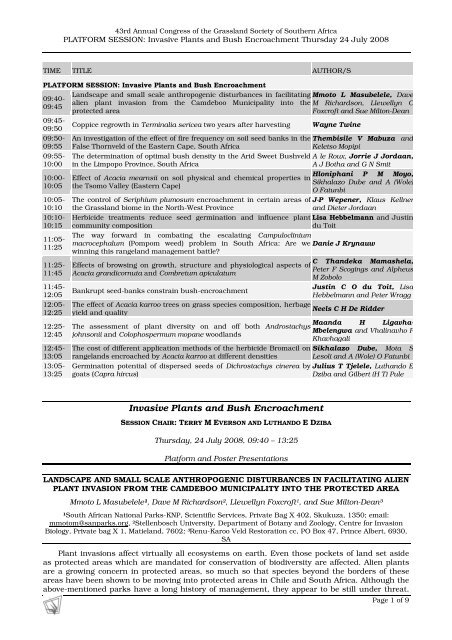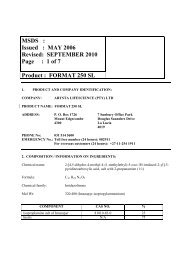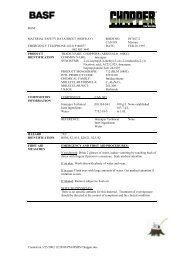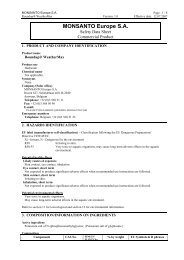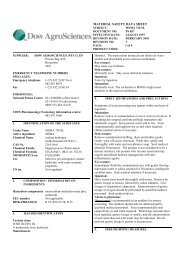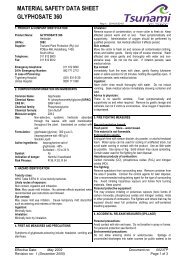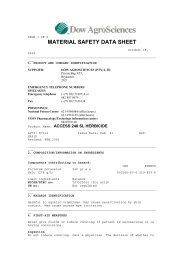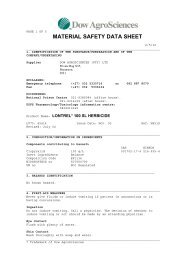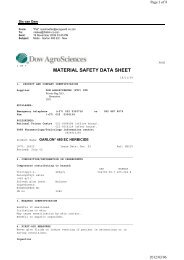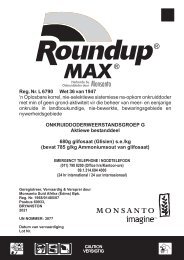Invasive Plants and Bush Encroachment
Invasive Plants and Bush Encroachment
Invasive Plants and Bush Encroachment
You also want an ePaper? Increase the reach of your titles
YUMPU automatically turns print PDFs into web optimized ePapers that Google loves.
43rd Annual Congress of the Grassl<strong>and</strong> Society of Southern Africa<br />
PLATFORM SESSION: <strong>Invasive</strong> <strong>Plants</strong> <strong>and</strong> <strong>Bush</strong> <strong>Encroachment</strong> Thursday 24 July 2008<br />
TIME TITLE AUTHOR/S<br />
PLATFORM SESSION: <strong>Invasive</strong> <strong>Plants</strong> <strong>and</strong> <strong>Bush</strong> <strong>Encroachment</strong><br />
L<strong>and</strong>scape <strong>and</strong> small scale anthropogenic disturbances in facilitating Mmoto L Masubelele, Dave<br />
09:40-<br />
alien plant invasion from the Camdeboo Municipality into the M Richardson, Llewellyn C<br />
09:45<br />
protected area<br />
Foxcroft <strong>and</strong> Sue Milton-Dean<br />
09:45-<br />
Coppice regrowth in Terminalia sericea two years after harvesting Wayne Twine<br />
09:50<br />
09:50- An investigation of the effect of fire frequency on soil seed banks in the Thembisile V Mabuza <strong>and</strong><br />
09:55 False Thornveld of the Eastern Cape, South Africa<br />
Keletso Mopipi<br />
09:55- The determination of optimal bush density in the Arid Sweet <strong>Bush</strong>veld A le Roux, Jorrie J Jordaan,<br />
10:00 in the Limpopo Province, South Africa<br />
A J Botha <strong>and</strong> G N Smit<br />
Hloniphani P M Moyo,<br />
10:00- Effect of Acacia mearnsii on soil physical <strong>and</strong> chemical properties in<br />
Sikhalazo Dube <strong>and</strong> A (Wole)<br />
10:05 the Tsomo Valley (Eastern Cape)<br />
O Fatunbi<br />
10:05- The control of Seriphium plumosum encroachment in certain areas of J-P Wepener, Klaus Kellner<br />
10:10 the Grassl<strong>and</strong> biome in the North-West Province<br />
<strong>and</strong> Dieter Jordaan<br />
10:10- Herbicide treatments reduce seed germination <strong>and</strong> influence plant Lisa Hebbelmann <strong>and</strong> Justin<br />
10:15 community composition<br />
du Toit<br />
The way forward in combating the escalating Campuloclinium<br />
11:05-<br />
macrocephalum (Pompom weed) problem in South Africa: Are we Danie J Krynauw<br />
11:25<br />
winning this rangel<strong>and</strong> management battle?<br />
11:25-<br />
11:45<br />
11:45-<br />
12:05<br />
12:05-<br />
12:25<br />
12:25-<br />
12:45<br />
12:45-<br />
13:05<br />
13:05-<br />
13:25<br />
C Th<strong>and</strong>eka Mamashela,<br />
Effects of browsing on growth, structure <strong>and</strong> physiological aspects of<br />
Peter F Scogings <strong>and</strong> Alpheus<br />
Acacia gr<strong>and</strong>icornuta <strong>and</strong> Combretum apiculatum<br />
M Zobolo<br />
Justin C O du Toit, Lisa<br />
Bankrupt seed-banks constrain bush-encroachment<br />
Hebbelmann <strong>and</strong> Peter Wragg<br />
The effect of Acacia karroo trees on grass species composition, herbage<br />
Neels C H De Ridder<br />
yield <strong>and</strong> quality<br />
Ma<strong>and</strong>a H Ligavha-<br />
The assessment of plant diversity on <strong>and</strong> off both Androstachys<br />
Mbelengwa <strong>and</strong> Vhalinavho P<br />
johnsonii <strong>and</strong> Colophospermum mopane woodl<strong>and</strong>s<br />
Khavhagali<br />
The cost of different application methods of the herbicide Bromacil on Sikhalazo Dube, Mota S<br />
rangel<strong>and</strong>s encroached by Acacia karroo at different densities Lesoli <strong>and</strong> A (Wole) O Fatunbi<br />
Germination potential of dispersed seeds of Dichrostachys cinerea by Julius T Tjelele, Luth<strong>and</strong>o E<br />
goats (Capra hircus)<br />
Dziba <strong>and</strong> Gilbert (H T) Pule<br />
<strong>Invasive</strong> <strong>Plants</strong> <strong>and</strong> <strong>Bush</strong> <strong>Encroachment</strong><br />
SESSION CHAIR: TERRY M EVERSON AND LUTHANDO E DZIBA<br />
Thursday, 24 July 2008, 09:40 – 13:25<br />
Platform <strong>and</strong> Poster Presentations<br />
LANDSCAPE AND SMALL SCALE ANTHROPOGENIC DISTURBANCES IN FACILITATING ALIEN<br />
PLANT INVASION FROM THE CAMDEBOO MUNICIPALITY INTO THE PROTECTED AREA<br />
Mmoto L Masubelele¹, Dave M Richardson², Llewellyn Foxcroft¹, <strong>and</strong> Sue Milton-Dean³<br />
¹South African National Parks-KNP, Scientific Services, Private Bag X 402, Skukuza, 1350; email:<br />
mmotom@sanparks.org, ²Stellenbosch University, Department of Botany <strong>and</strong> Zoology, Centre for Invasion<br />
Biology, Private bag X 1, Matiel<strong>and</strong>, 7602; ³Renu-Karoo Veld Restoration cc, PO Box 47, Prince Albert, 6930,<br />
SA<br />
Plant invasions affect virtually all ecosystems on earth. Even those pockets of l<strong>and</strong> set aside<br />
as protected areas which are m<strong>and</strong>ated for conservation of biodiversity are affected. Alien plants<br />
are a growing concern in protected areas, so much so that species beyond the borders of these<br />
areas have been shown to be moving into protected areas in Chile <strong>and</strong> South Africa. Although the<br />
above-mentioned parks have a long history of management, they appear to be still under threat.<br />
Page 1 of 9
43rd Annual Congress of the Grassl<strong>and</strong> Society of Southern Africa<br />
PLATFORM SESSION: <strong>Invasive</strong> <strong>Plants</strong> <strong>and</strong> <strong>Bush</strong> <strong>Encroachment</strong> Thursday 24 July 2008<br />
Camdeboo National Park (CNP) has been recently proclaimed by South African National Parks. It<br />
has a unique setting with the park surrounding the Camdeboo Municipality. It provides the<br />
perfect opportunity to investigate the spread of invasive alien plants in relation to historic <strong>and</strong><br />
current l<strong>and</strong> use in a protected area surrounding a municipal area or district. We predict that (1)<br />
invasive alien plants will move from the town <strong>and</strong> disturbed peri-urban areas into the park <strong>and</strong> (2)<br />
that vegetation types nearest to dams, rivers <strong>and</strong> previously farmed <strong>and</strong> highly eroded areas will<br />
be invaded by more species of alien plants than less disturbed <strong>and</strong> drier environments. We predict<br />
that the greatest densities of invasive alien plants will occur in highly disturbed areas with high<br />
propagule pressure adjacent to the Camdeboo Municipality. Ecology of important IAP in the<br />
Camdeboo Municipality will be further investigated to underst<strong>and</strong> the patterns of spread into the<br />
park. An invasive alien plant removal experiment in combination with post clearing rehabilitation<br />
will be carried out to evaluate the cost effectiveness of revegetation following alien clearing.<br />
Appropriate management prioritization approaches will be developed that will be appropriate for<br />
the CNP <strong>and</strong> similar environments.<br />
COPPICE REGROWTH IN TERMINALIA SERICEA TWO YEARS AFTER HARVESTING<br />
Wayne Twine<br />
University of the Witwatersr<strong>and</strong>, School of Animal, Plant <strong>and</strong> Environmental Sciences, c/o Wits Rural<br />
Facility, P/Bag X420, Acornhoek, 1360, email: rcrd@global.co.za<br />
This poster reports on coppice regrowth characteristics of Terminalia sericea, (a savanna tree<br />
species widely used for fuelwood by rural communities) two years after being felled. In April 2005,<br />
trees were felled in the Wits Rural Facility, Limpopo Province, as part of a fire-break clearing<br />
exercise. In April 2007, 65 of these stumps were revisited to measure coppice re-growth. Only<br />
single-stemmed trees were included in this analysis. Stump circumference, height <strong>and</strong> distance<br />
to nearest neighbouring tree were measured for cut individuals. The number of coppice shoots<br />
per stump was counted. The basal circumference <strong>and</strong> length of each of the 347 coppice shoots<br />
was measured. Stump <strong>and</strong> shoot circumferences were used to calculate basal areas. Harvested<br />
trees produced a mean of 5.3 coppice shoots, or 0.5 shoots per cm of stump circumference, over<br />
the two year period. The number of coppice shoots per stump increased linearly with increase in<br />
stump circumference, but was negatively affected by proximity to the nearest tree. The ratio of<br />
summed basal area of coppice shoots to basal area of the stump decreased with stump height.<br />
Both circumference <strong>and</strong> length of individual coppice shoots appeared to be negatively affected by<br />
inter-ramet competition (total number of coppice shoots). Shoots had reached a mean size of 3.5<br />
cm in circumference <strong>and</strong> 78.6 cm in length after two years. Recommendations for sustainable<br />
coppice harvesting are made.<br />
AN INVESTIGATION OF THE EFFECT OF FIRE FREQUENCY ON SOIL SEED BANKS IN THE<br />
FALSE THORNVELD OF THE EASTERN CAPE, SOUTH AFRICA<br />
Thembisile V Mabuza 1, 2 <strong>and</strong> Keletso Mopipi 1<br />
1University of Fort Hare, Department of Livestock <strong>and</strong> Pasture Science, Private Bag X1314, Alice, 5700,<br />
South Africa., 2 ARC-LBD, Private Bag X2, Irene, 0062, email: mabuzatv@arc.agric.za<br />
Fire plays a critical role in structuring plant communities by controlling bush encroachment,<br />
eradication of unwanted species <strong>and</strong> reduction of moribund grass. Fire also triggers germination<br />
by breaking seed dormancy through smoke <strong>and</strong> heat. However, some of the soil seed banks can<br />
be negatively affected by fire cues. A study was conducted to investigate the effect of fire frequency<br />
on seed germination. It was carried out on long-term fire trials established in 1980 at University<br />
of Fort Hare Research farm in the False Thornveld of the Eastern Cape. Six treatments were<br />
applied on twelve 50 m x 100 m plots arranged in a complete r<strong>and</strong>omized design <strong>and</strong> replicated<br />
once. These comprised a spring Annual burn, Biennial burn, Triennial burn, Quadrennial burn,<br />
Sixennial burn <strong>and</strong> no burn. Fifty soil cores were r<strong>and</strong>omly collected on a 50 m x 50 m transect<br />
from each plot in August 2007, 30 ml of the soil samples from each plot were spread on trays<br />
containing growth medium <strong>and</strong> seeds were allowed to germinate in a greenhouse. Emerging<br />
seedlings were counted every day for 13 weeks. The results indicated a significant treatment effect<br />
on seedling emergence (P≤0.05). The highest number of seedlings emerged from the sixennial burn<br />
<strong>and</strong> the lowest from the biennial burn. The results indicate that the longer the fire interval the<br />
larger the seed banks. Therefore fire frequency must be considered in the restoration of burned<br />
areas.<br />
Page 2 of 9
43rd Annual Congress of the Grassl<strong>and</strong> Society of Southern Africa<br />
PLATFORM SESSION: <strong>Invasive</strong> <strong>Plants</strong> <strong>and</strong> <strong>Bush</strong> <strong>Encroachment</strong> Thursday 24 July 2008<br />
THE DETERMINATION OF OPTIMAL BUSH DENSITY IN THE ARID SWEET BUSHVELD IN<br />
THE LIMPOPO PROVINCE, SOUTH AFRICA<br />
A le Roux 1 , Jorrie J Jordaan 2 , A J Botha 3 <strong>and</strong> G N Smit 4<br />
1P.O. Box 1837, Bela Bela 0480, South Africa., 2 Towoomba ADC, Private Bag X1615, Bela Bela, 0480, South<br />
Africa, email: jordaanj@agric.limpopo.gov.za, 3 Department of Nature Conservation, Tshwane University of<br />
Technology, Private Bag X680, Pretoria 000, 4 Department of Animal, Wildlife <strong>and</strong> Grassl<strong>and</strong> Sciences,<br />
University of the Free State, P.O. Box 339, Bloemfontein 9300<br />
A study to determine the optimal bush density in the Arid Sweet <strong>Bush</strong>veld of the Thabazimbi<br />
district was done over a period of five years (1993 to 1997). Treatments consisted of seven plots,<br />
each 60 m X 200 m in size. A control plot, with a bush density of approximately 8000 trees or<br />
20708 ETTE (Evapotranspiration Tree Units) ha -1 , was used as a benchmark, which represented<br />
100% of the bush density of the study area. Six other plots were thinned to different bush<br />
densities, representing 75%, 50%, 35%, 20%, 10% <strong>and</strong> 0% (total clearing) of the bush density of<br />
the control site, respectively. Plots were thinned via cut stump treatments with a spray mix<br />
consisting of a 1% Picloram/Triclopyr solution in diesel, applied with rucksack sprayers during<br />
September 1992. Botanical surveys were conducted annually at each site in one permanent 5 m X<br />
200 m transect to determine grass production <strong>and</strong> grass species composition in three subhabitats<br />
(between trees, under trees <strong>and</strong> where trees used to be). Twenty topsoil samples were<br />
r<strong>and</strong>omly collected per sub-habitat in each plot. They were pooled <strong>and</strong> a st<strong>and</strong>ard soil chemical<br />
analysis was done for each collective samples (two samples per plot in the 100% <strong>and</strong> 0%<br />
treatment, three samples in the others). Plots were grazed during each winter to prevent the<br />
accumulation of grass material.<br />
Grass species composition in all treatments progressed towards higher succession. Long<br />
rest periods during the growing season resulted progressive changes in the grass layer in all plots.<br />
The grass layer changed from a pioneer stage, dominated by annual grass species, to a climax<br />
situation dominated by desirable species. The basal cover of the grass layer improved to the extent<br />
where most of the bare patches that occurred before tree thinning were covered.<br />
In all the treatments, the dry matter production of the grass layer increased. The increased<br />
production could be ascribed to the long rest periods, as well as the decreased competitive effect<br />
of the woody component after selective thinning.<br />
Grass production increased in large intervals between the 0% (all trees removed) <strong>and</strong><br />
the 50% treatment (50% trees removed). Between the 50% <strong>and</strong> the 100% (no trees removed)<br />
treatment, grass production also increased, but the increases were smaller between each<br />
treatments. The highest increase in grass production was obtained in the in the 35% plot<br />
(approximately 4 000 ETTU ha -1 ; 65% trees removed). In all treatments where more than 65% of<br />
the trees were removed, lower production advantages were ascribed to the loss of Panicum<br />
maximum due to sub-habitat changes. A tree density of approximately 2800 trees or 4063 ETTU<br />
ha -1 (the 35% treatment) appeared to be the ideal treatment.<br />
No significant differences in soil chemical composition were noted between the<br />
distinguished sub habitats. Although insignificant, different nutrients occurred in higher<br />
concentrations under trees <strong>and</strong> at locations where trees were removed.<br />
EFFECT OF ACACIA MEARNSII ON SOIL PHYSICAL AND CHEMICAL PROPERTIES IN THE<br />
TSOMO VALLEY (EASTERN CAPE)<br />
Hloniphani P M Moyo, Sikhalazo Dube, A (Wole) O Fatunbi<br />
University of Fort Hare, Department of Livestock <strong>and</strong> Pasture, Private Bag X1314, Alice 5700, South Africa,<br />
email: sdube@ufh.ac.za<br />
<strong>Invasive</strong> plants are known to alter the edaphic properties of an ecosystem through their<br />
encumbrance that often task the soil nutrient <strong>and</strong> other physico-chemical properties. Most times<br />
these species disrupt the balance among components of the ecosystem leading to reduced<br />
productivity, economic loss <strong>and</strong> degradation. Acacia mearnsii is a fast growing invasive tree<br />
species whose effect is attaining economic importance in many part of South Africa especially in<br />
the riparian ecosystem. The consequences of the invasion of this species has not been well<br />
defined, although it has been proven to remove substantial quantity of soil water, speculated to<br />
exact some allelopathic effect on grass <strong>and</strong> broad leaves species <strong>and</strong> affect the re-growth of<br />
Page 3 of 9
43rd Annual Congress of the Grassl<strong>and</strong> Society of Southern Africa<br />
PLATFORM SESSION: <strong>Invasive</strong> <strong>Plants</strong> <strong>and</strong> <strong>Bush</strong> <strong>Encroachment</strong> Thursday 24 July 2008<br />
natural vegetation after removal. The mechanism for these effects has not been documented but<br />
the later speculation suggested that A. mearnsii invasion could have some effects on soil physicochemical<br />
<strong>and</strong> biological properties. We therefore conducted this study with the aim of<br />
underst<strong>and</strong>ing the effects of A. mearnsii invasion on soil properties at Tsomo valley in the Eastern<br />
Cape of South Africa.<br />
Surface soil samples (0-15 cm) were collected from five locations that have been invaded for<br />
up to six years. A nearby un-invaded location was also sampled for each of the five locations as a<br />
control for comparison. The samples were analyzed for, pH (H 2O), electrical conductivity (EC), <strong>and</strong><br />
soil organic matter. Individual pH values for the samples differed but were not statistically<br />
different from each other. Presence of Acacia mearnsii <strong>and</strong> its litter did not have any significant<br />
(P>0.05) effect on soil pH, electricity conductivity <strong>and</strong> soil aggregate stability (Slow wetting, fast<br />
wetting <strong>and</strong> mechanical disintegration). There was negative correlation (r = -0.420) between pH<br />
<strong>and</strong> aggregate stability mean weight diameter for slow wetting. The presence of Acacia mearnsii<br />
had a significant effect on soil organic carbon. This can be attributed to the high organic matter<br />
content under the Acacia mearnsii st<strong>and</strong>s that increased the organic matter percentage compared<br />
to the soils that were from ‘outside’ the Acacia mearnsii st<strong>and</strong>s. We therefore concluded that the<br />
presence of Acacia mearnsii had no effect on soil physico-chemical properties, which imply that<br />
the observed reduced vegetation <strong>and</strong> species diversity in areas invaded by Acacia mearnsii are not<br />
due to altered soil physicochemical properties.<br />
THE CONTROL OF SERIPHIUM PLUMOSUM ENCROACHMENT IN CERTAIN AREAS OF THE<br />
GRASSLAND BIOME IN THE NORTH-WEST PROVINCE<br />
J-P Wepener 1 , Klaus Kellner 1 <strong>and</strong> Dieter Jordaan 2<br />
1North-West University (Potchefstroom Campus), School of Environmental Sciences <strong>and</strong> Development,<br />
Private Bag X6001, Potchefstroom, 2520, South Africa, email: plbjpw@puk.ac.za, 2 Department of Agriculture<br />
North-West Province, Private Bag 484, Potchefstroom, 2520, South Africa<br />
Seriphium plumosum (previously known as Stoebe vulgaris), also known as bankrupt bush or<br />
slangbos, is commonly associated with degraded rangel<strong>and</strong>s in the semi- arid <strong>and</strong> arid grassl<strong>and</strong>s<br />
of South Africa. The encroachment of Seriphium plumosum into natural veld is a huge problem for<br />
farmers, especially in the Free State <strong>and</strong> North - West Provinces, as it reduces the grazing<br />
capacity of the veld. <strong>Bush</strong> encroachment into natural veld is a form of l<strong>and</strong> degradation possibly<br />
induced by human activities such as overgrazing <strong>and</strong> wrongful management of fire, which leads to<br />
an imbalance in the ratio between the herbaceous <strong>and</strong> woody components in the grassl<strong>and</strong>. The<br />
abundance of palatable, perennial grasses (“decreasers”) is greatly reduced when the crown cover<br />
of S. plumosum exceeds 70%. Old ab<strong>and</strong>oned cropl<strong>and</strong>s have the highest density of S. plumosum,<br />
which is often associated with patches of bare ground. <strong>Encroachment</strong> does not only refer to<br />
thickening of alien vegetation, but also refers to the thickening of indigenous woody species such<br />
as S. plumosum.<br />
Farmers in the North - West Province have used different technologies to control S. plumosum<br />
encroachment. These include burning, hacking <strong>and</strong> the use of herbicides. One of the aims of this<br />
project is to evaluate the success of all possible control methods applied by l<strong>and</strong> users in the<br />
study area. Results show that the long term success rate achieved with most technologies is<br />
limited, when a follow up control programme is not implemented. In sites where a non-selective<br />
herbicide application method (tractor mounted bulk sprayer) was used, both the densities of<br />
shrubs <strong>and</strong> decreaser grass species were reduced with an increase in pioneer species, indicating a<br />
disturbance <strong>and</strong> degradation of the l<strong>and</strong>. At the sites where a soil applied herbicide was used for<br />
the control of S. plumosum the initial success of the control was very high, although it is still<br />
recommended that follow up control is implemented.<br />
Due to the limited knowledge of the dynamics <strong>and</strong> phenology of S. plumosum leading to<br />
encroachment, the second aim of the study was to investigate certain aspects of the plant<br />
phenology, such as time of active growth, seed production <strong>and</strong> seed dispersal, to give guidelines<br />
as to when control should be implemented for the highest success rate of the control technique.<br />
With regard to the population demography of S. plumosum, it was determined that the period of<br />
active growth is from August to early March. The reproductive phase of S. plumosum lasts from<br />
December to the end of May. This implies that control should be done during the active growing<br />
period of the plant, for the herbicide to be effective <strong>and</strong> before the reproductive period of the plant<br />
commences to prevent seeds from being dropped.<br />
Page 4 of 9
43rd Annual Congress of the Grassl<strong>and</strong> Society of Southern Africa<br />
PLATFORM SESSION: <strong>Invasive</strong> <strong>Plants</strong> <strong>and</strong> <strong>Bush</strong> <strong>Encroachment</strong> Thursday 24 July 2008<br />
HERBICIDE TREATMENTS REDUCE SEED GERMINATION AND INFLUENCE PLANT<br />
COMMUNITY COMPOSITION<br />
Lisa Hebbelmann <strong>and</strong> Justin du Toit<br />
School of Biological <strong>and</strong> Conservation Sciences, University of KwaZulu-Natal<br />
Pietermaritzburg, Private Bag X01, Scottsville 3209, South Africa<br />
E-mail address: lisahebbelmann@gmail.com<br />
Herbicides are used selectively or non-selectively to kill plants. Glyphosate is a widely used<br />
herbicide about which there are two schools of thought, one of which supports evidence that<br />
glyphosate has residual activity in the soil having pre-emergence effects on germination <strong>and</strong> long<br />
term effects on treated plant communities, <strong>and</strong> the other does not. We predicted that glyphosate<br />
would reduce the germination of both monocotyledenous <strong>and</strong> dicotyledenous seeds. The<br />
application of glyphosate in increasing herbicide concentration showed that the decrease in<br />
gernimation is proportional to the increase in glyphosate concentration. When treated with<br />
glyphosate at varying times with relation to the day of planting, the age of the glyphosate in the<br />
soil was positively related to the proportion of seeds that germinated. The older the glyphosate,<br />
the lower the reduction in germination. The non-selective herbicide treatement affected both<br />
vegetatoin structure <strong>and</strong> plant community composition of three vegetation types, along a gradient<br />
of invasion. The non-selective herbicide (glyphosate) impeded grass establishment, but the<br />
selective herbicide (picloram) has no effect. Grass biomass influences further control of alien<br />
vegetation with fire. Therefore the selective herbicide should be used as an alternative to the<br />
selective herbicide glyphosate.Weed species (herbaceous alien invaders <strong>and</strong> others characteristic<br />
of degraded areas) dominated the plant community that established after glyphosate<br />
THE WAY FORWARD IN COMBATING THE ESCALATING CAMPULOCLINIUM<br />
MACROCEPHALUM (POMPOM WEED) PROBLEM IN SOUTH AFRICA: ARE WE WINNING THIS<br />
RANGELAND MANAGEMENT BATTLE?<br />
Danie J Krynauw<br />
Department of Nature Conservation, Tshwane University of Technology, South Africa, email:<br />
Krynauwdj@tut.ac.za<br />
The problem caused by the category 1 alien invasive weed, Campuloclinium macrocephalum<br />
(Pompom weed) is progressively becoming worse in South Africa. This invasive plant of grassl<strong>and</strong>s<br />
<strong>and</strong> open savannas has captured the attention of concerned persons over the past few years, <strong>and</strong><br />
is considered by many to be one of the worst emerging weeds that South Africa has ever had to<br />
contend with. This weed, being a perennial, hardy <strong>and</strong> adaptable plant, establishes itself well in a<br />
variety of vegetation types <strong>and</strong> habitats. Added to this is its ability to produce large amounts of<br />
seeds, in a manner very similar to that of annual weeds. Pompom weed also seems to flourish<br />
<strong>and</strong> establish under good rainfall conditions, such as those experienced during the past summer<br />
season or two.<br />
Pompom weed threatens rangel<strong>and</strong>s in two main ways. Firstly, it has a serious impact on the<br />
biodiversity of veld, as it out-competes <strong>and</strong> replaces many indigenous plants. This is a serious<br />
concern from a conservation viewpoint. Secondly, it drastically lowers the grazing capacity of<br />
invaded veld, where it often becomes the dominant plant. Pompom weed is not utilized by large<br />
herbivores, <strong>and</strong> therefore causes a drastic decline in the feed value of invaded veld.<br />
Herbicides have been registered to control Pompom weed, but implementation of the<br />
herbicide-based control programs has been slow, with the present rates of spread mostly negating<br />
the control efforts. Research on finding suitable biological control agents is in progress, but<br />
releases of such organisms may still be years away. A priority is also to find more suitable<br />
herbicides, <strong>and</strong> suitable application periods. This is a difficult issue, as the scope of possible<br />
suitable herbicides is very limited. Mechanical control has been ruled out as a valid control<br />
option, because of the weed’s considerable regenerative abilities.<br />
The Pompom weed problem is evidently not one that can be tackled in a casual way. If this<br />
important alien invasive weed is to be controlled effectively, drastic, coordinated <strong>and</strong> serious<br />
actions need to be taken. Proposals in this regard will be made.<br />
Page 5 of 9
43rd Annual Congress of the Grassl<strong>and</strong> Society of Southern Africa<br />
PLATFORM SESSION: <strong>Invasive</strong> <strong>Plants</strong> <strong>and</strong> <strong>Bush</strong> <strong>Encroachment</strong> Thursday 24 July 2008<br />
EFFECTS OF BROWSING ON GROWTH, STRUCTURE AND PHYSIOLOGICAL ASPECTS OF<br />
ACACIA GRANDICORNUTA AND COMBRETUM APICULATUM<br />
C Th<strong>and</strong>eka Mamashela, Peter F Scogings <strong>and</strong> Alpheus M Zobolo<br />
University of Zulul<strong>and</strong>, Department of Agriculture, Private Bag X1001, KwaDlangezwa 3886, South Africa,<br />
email: mamashelas@webmail.co.za<br />
Very little is known about plants growing in savannas, especially how woody plants respond<br />
to browsing <strong>and</strong> variations in resources. It is assumed that growth rate <strong>and</strong> concentrations of<br />
defenses are inversely related, but will be affected by resource availability. For that reason,<br />
research was conducted to investigate the effects of browsing on Acacia gr<strong>and</strong>icornuta <strong>and</strong><br />
Combretum apiculatum. Research was conducted at the Nkuhlu experimental exlcosures (Kruger<br />
National Park) on these two species. The exclosures are designed so that there are three broad<br />
levels of browsing pressure: no mammal herbivores excluded, elephants <strong>and</strong> giraffes excluded <strong>and</strong><br />
all mammal herbivores bigger than hares excluded, all of which incorporate the catena from sodic<br />
footslope to s<strong>and</strong>y crests. The focus was on heavily browsed plants between the heights of 0.7-1.7<br />
m. Ten individuals per species per treatment (full, partial <strong>and</strong> no exclosure) were sampled <strong>and</strong><br />
height <strong>and</strong> basal circumference were measured early <strong>and</strong> late in the wet season. Five new shoots<br />
per tree were marked; these shoots were re-measured at intervals to monitor their growth. The<br />
results showed that there was a positive effect of browsing since A. gr<strong>and</strong>icornuta in the no<br />
exclosure <strong>and</strong> C. apiculatum in the partial exclosure had longer shoots compared to the full<br />
exclosure (Figure 1) (98.62 mm for C. apiculatum in the partial exclosure) Acacia gr<strong>and</strong>icornuta<br />
thorns were longer under browsing (24.7 mm in the non exclosure) than those in the full<br />
exclosure (13.7 mm). A nursery experiment was conducted to see the effects of browsing as<br />
affected by water availability. Potted seedlings of Combretum apiculatum were given to goats to<br />
achieve a range of browsing intensities in October (0, 30, 60 <strong>and</strong> 90%). <strong>Plants</strong> were weighed before<br />
<strong>and</strong> after browsing to estimate the amount removed, <strong>and</strong> were separated into three groups that<br />
were watered every 3, 7 <strong>and</strong> 10 days for four months. <strong>Plants</strong> were re-measured, harvested,<br />
separated into morphological parts (roots, shoots <strong>and</strong> leaves) <strong>and</strong> each part weighed. Browsing<br />
had an effect on shoots of plants that were watered biweekly (non-linear response) <strong>and</strong> those<br />
watered weekly (negative response); water had a positive effect on leaves, shoots <strong>and</strong> stem<br />
circumference.<br />
Average Shoot Length (mm)<br />
160<br />
140<br />
120<br />
100<br />
80<br />
60<br />
40<br />
20<br />
Acacia<br />
gr<strong>and</strong>icornuta<br />
Combretum<br />
apiculatum<br />
0<br />
Full<br />
Exclosure<br />
Partial<br />
Exclosure<br />
Non<br />
Exclosure<br />
Figure 1: Average Shoot Length (mm) for A. gr<strong>and</strong>icornuta <strong>and</strong> C. apiculatum in different<br />
exclosures.<br />
Page 6 of 9
43rd Annual Congress of the Grassl<strong>and</strong> Society of Southern Africa<br />
PLATFORM SESSION: <strong>Invasive</strong> <strong>Plants</strong> <strong>and</strong> <strong>Bush</strong> <strong>Encroachment</strong> Thursday 24 July 2008<br />
BANKRUPT SEED-BANKS CONSTRAIN BUSH-ENCROACHMENT<br />
Justin C O du Toit, Lisa Hebbelmann, Peter Wragg<br />
University of KwaZulu-Natal, Discipline of Grassl<strong>and</strong> Science, email: dutoitjco@ukzn.ac.za<br />
The seeds of many African Acacias can remain dormant in dry soil for many years, being<br />
prompted to germinate by favourably moist conditions. Thus, periods of particularly wet weather<br />
in arid regions might cause prolific germination of Acacia seeds; this cohort of plants could then<br />
establish <strong>and</strong> grow, resulting in ‘bush encroachment’. The South African portion of the Kalahari<br />
received heavy, prolonged rain during the 2005/06 season, affording an opportunity to test this<br />
rain-induced mass-germination hypothesis by assessing seedling density <strong>and</strong> determining<br />
whether or not seedling density was related to spatial variation in rainfall. Seedling density was<br />
estimated near 15 rain gauges scattered across 54 500 ha of Tswalu Kalahari Reserve. Only under<br />
the canopies of Acacia mellifera were appreciable numbers of seedlings found (0.427 0.013<br />
conspecific seedlings m-2). Elsewhere, all Acacia seedling densities were lower than 0.06 m-2.<br />
Further, there was no relation between local rainfall <strong>and</strong> seedling density. These results indicate<br />
that rainfall of this magnitude does not necessarily induce mass germination of Acacia seedlings<br />
in this area. A second hypothesis – that the Acacia seed-bank is very small, precluding massgermination<br />
– was tested the following year. The size of the Acacia seed-bank in the top 5 cm of<br />
the soil was estimated at 22 sites across Tswalu (in total 646 quadrats). Only 25 seeds were<br />
found (>97% of all quadrats had no seeds), these being A. mellifera (12 seeds), Acacia erioloba (10<br />
seeds), <strong>and</strong> Acacia haematoxylon (3 seeds). This hypothesis was accepted, <strong>and</strong> we conclude that<br />
seed-bank size is an important driver of Acacia recruitment in the southern Kalahari.<br />
THE EFFECT OF ACACIA KARROO TREES ON GRASS SPECIES COMPOSITION, HERBAGE<br />
YIELD AND QUALITY<br />
Neels C H De Ridder<br />
Eastern Cape Department of Agriculture, Döhne Agricultural Development Institute, P/Bag X15 Stutterheim<br />
4930<br />
The encroachment of Acacia karroo (Thorn) trees in the Sweetveld areas has widely been seen<br />
as undesirable by the farming industry. Farmers believe that Thorn trees are highly competitive<br />
to grass production. In the hope of increased grass yield, farmers spend large amounts of money<br />
to eradicate this so-called problem. These methods can vary between mechanical; chemical; <strong>and</strong><br />
or physical plant removal practices, all of which is costly to perform. The main aim of these<br />
practices is to ultimately increase grass production; animal performance; <strong>and</strong> farming profit.<br />
Earlier research work undertaken during 2002, has proven that average to low Thorn tree<br />
populations increased grass production. These results also revealed that palatable grass species<br />
contributed higher percentages of the biomass produced under canopies <strong>and</strong> that the opposite<br />
was true within open areas where unpalatable grasses contributed more.<br />
Another finding was that the animals proved to be biased towards palatable species resulting<br />
in more pressured grazing within <strong>and</strong> amongst trees, avoiding open areas. Areas were heavily<br />
selected by animals because of species <strong>and</strong> quality, therefore creating an illusion of decreased<br />
grass production under <strong>and</strong> surrounding trees.<br />
Although initial results proved that Thorn trees do not effect grass production negatively <strong>and</strong><br />
that only under very dense st<strong>and</strong>s was marginal differences measured during dry seasons, this<br />
visual illusion still had most of the farming sector in disbelieve. To further prove these results a<br />
second demonstration site was picked during 2005. At this site it was also believed that Thorn<br />
trees negatively effected grass production. Enclosures were r<strong>and</strong>omly distributed before grazing<br />
commenced. Samples were taken within four different tree density classes (within clumps of trees,<br />
in open spaced areas; under tree canopies facing north; <strong>and</strong> under tree canopies facing south).<br />
After the camp was grazed <strong>and</strong> the animals removed, biomass samples were taken from the inside<br />
of the enclosures (ungrazed) <strong>and</strong> the outside of the enclosures (grazed). Samples were dried <strong>and</strong><br />
weighed to determine biomass produced <strong>and</strong> analyzed to determine quality. Results again proved<br />
that the Thorn tree population at this site did not jeopardize grass production in any way. It<br />
would not be justified to eradicate any Thorn trees at this site, instead, these trees should be seen<br />
as beneficial to the farmer <strong>and</strong> his farming enterprise. To make better use of this source of<br />
browsing animals such as goats <strong>and</strong> game could be possibilities. These animals could utilize this<br />
Page 7 of 9
43rd Annual Congress of the Grassl<strong>and</strong> Society of Southern Africa<br />
PLATFORM SESSION: <strong>Invasive</strong> <strong>Plants</strong> <strong>and</strong> <strong>Bush</strong> <strong>Encroachment</strong> Thursday 24 July 2008<br />
plant species to the financial benefit of the farmer, <strong>and</strong> succeed in controlling re-growth <strong>and</strong><br />
thickening as an extra bonus.<br />
THE ASSESSMENT OF PLANT DIVERSITY ON AND OFF BOTH ANDROSTACHYS JOHNSONII<br />
AND COLOPHOSPERMUM MOPANE WOODLANDS<br />
Ma<strong>and</strong>a H Ligavha-Mbelengwa 1 <strong>and</strong> Vhalinavho P Khavhagali 2<br />
1University of Venda, Botany Department, P/Bag x5050, Thohoy<strong>and</strong>ou, Limpopo Province, 0950, South<br />
Africa, email: ligav@univen.ac.za, 2 Department of Tourism, Environment <strong>and</strong> Conservation, 224 Du Toitspan<br />
Road, P/Bag x6102, Kimberly, 8301, Northern Cape Province, South Africa<br />
The assessment of plant diversity on <strong>and</strong> off both Androstachys johnsonii (A. johnsonii) <strong>and</strong><br />
Colophospermum mopane (C. mopane) st<strong>and</strong>s was conducted. Both these two plant species grow<br />
on s<strong>and</strong>y <strong>and</strong> loam soils at Makuya Nature Reserve. Species quantification included identification,<br />
counting <strong>and</strong> recording per quadrat of about 2 m x 2 m on six plots. Differences in species<br />
diversity <strong>and</strong> abundance on <strong>and</strong> off both A. johnsonii <strong>and</strong> C. mopane st<strong>and</strong>s were observed. Plant<br />
diversity was found to be higher on the plots that were away from both the st<strong>and</strong>s of A. johnsonii<br />
<strong>and</strong> C. mopane on loam soil than in the st<strong>and</strong>s that were under A. johnsonii <strong>and</strong> C. mopane on<br />
s<strong>and</strong>y soil. However, on s<strong>and</strong>y soil, plant diversity was also high under C. mopane st<strong>and</strong> but low<br />
on both under <strong>and</strong> away A. johnsonii st<strong>and</strong>s. Loam soil st<strong>and</strong>s are more fertile than s<strong>and</strong>y soil<br />
st<strong>and</strong>s; it is therefore not puzzling to observe numerous plant species on loam soils than on s<strong>and</strong>y<br />
soils. On the other h<strong>and</strong> fewer species under A. johnsonii than under C. mopane on s<strong>and</strong>y soil is<br />
probable sign of presence of allelochemicals in soils under A. johnsonii than those under C.<br />
mopane.<br />
THE COST OF DIFFERENT APPLICATION METHODS OF THE HERBICIDE BROMACIL ON<br />
RANGELANDS ENCROACHED BY ACACIA KARROO AT DIFFERENT DENSITIES<br />
Sikhalazo Dube 1 , Mota S Lesoli 1 <strong>and</strong> A (Wole) O Fatunbi 2<br />
1Dept of Livestock <strong>and</strong> Pasture Science, University of Fort Hare, P. Bag X1314, Alice 5700, 2 ARDRI,<br />
University of Fort Hare, P. Bag X1314, Alice 5700, email: sdube@ufh.ac.za<br />
The encroachment of woody plants into grassl<strong>and</strong> is a global problem. Different methods have<br />
been used to control bush encroachment <strong>and</strong> most of them have been ineffective in the total<br />
elimination of bush encroachment. They are a number of chemicals that have been used in<br />
controlling bush encroachment. Consequently, large volumes of potentially hazardous chemicals,<br />
produced by various industries <strong>and</strong> agricultural operations, are entering the ecosystem. Bromacil,<br />
a broad spectrum herbicide, is used to control undesirable woody plants on noncropl<strong>and</strong> so as to<br />
increase the carrying capacity of the veld. The active ingredient (bromacil) is carried into the root<br />
zone by rain. It is readily absorbed through the root system <strong>and</strong> is then translocated to foliage.<br />
The leaves then become yellow <strong>and</strong> abscise. When new leaves are formed, they also turn yellow<br />
<strong>and</strong> abscise. This process continues until the tree no longer has reserves to initiate re-growth <strong>and</strong><br />
so it dies. A study was undertaken at the Honeydale research farm of the University of Fort Hare<br />
in the Eastern Cape to estimate the costs of three application methods of bromacil. Honeydale<br />
research farm is 520m above sea level <strong>and</strong> is about 32.8º S <strong>and</strong> 26.9º E in a semi-arid False<br />
Thornveld of the Eastern Cape, receiving mean annual rainfall of 480mm. In South Africa<br />
bromacil is traded as <strong>Bush</strong>Wacker <strong>and</strong> it is applied as a spray, spread dry just before or during<br />
the period of active growth, preferably when rain can be expected for soil activation or aerial<br />
application of granules (5kg.ha -1 ).<br />
Two paddocks, one of low <strong>and</strong> the other high density Acacia karroo, were identified. In each<br />
paddock 6 x 200m 2 plots were marked. Bromacil was applied to Acacia karroo plants in the<br />
marked plots; 2 of the plots were subjected to liquid spraying; the other 2 to granular spreading<br />
<strong>and</strong> the remaining 2 were used as controls. Teams working were monitored as was the amount of<br />
herbicide used in each plot. The cost of aerial application was known before h<strong>and</strong>. Total cost of<br />
each method per hectare was calculated, it included labour <strong>and</strong> chemical costs, furthermore, it<br />
was ascertained that the minimum area that can be aerially sprayed is 50 ha.<br />
The result indicated that, on a per hectare basis, it was more expensive to apply h<strong>and</strong> apply<br />
granules in the high density plots (R2700.ha -1 ) compared to either spraying liquid (R675.ha -1 ) or<br />
aerial spraying (R600.ha -1 ). Under low tree density aerial spraying, the cost of which does not<br />
Page 8 of 9
43rd Annual Congress of the Grassl<strong>and</strong> Society of Southern Africa<br />
PLATFORM SESSION: <strong>Invasive</strong> <strong>Plants</strong> <strong>and</strong> <strong>Bush</strong> <strong>Encroachment</strong> Thursday 24 July 2008<br />
change with density, was more expensive compared to h<strong>and</strong> application of granules (R389.ha -1 )<br />
compared to either spraying liquid (R207.ha -1 ). The cost of water used in the mixing was minimal<br />
<strong>and</strong> was not included in the calculations.<br />
We conclude that the full economic implications of the application methods can only be fully<br />
comprehended when the biophysical components are assessed such as mortality rate of Acacia<br />
karroo plants <strong>and</strong> biomass accumulation of the herbaceous materials. H<strong>and</strong> application<br />
(spreading <strong>and</strong> spraying) may be more important for smaller invasions while aerial application<br />
may be suitable for larger areas.<br />
GERMINATION POTENTIAL OF DISPERSED SEEDS OF DICHROSTACHYS CINEREA BY<br />
GOATS (CAPRA HIRCUS)<br />
Julius T Tjelele, Luth<strong>and</strong>o E Dziba, Gilbert (H T) Pule<br />
ARC Animal Production Institute, Irene, 0062, South Africa, email: jtjelele@arc.agric.za<br />
Woody plant encroachment is one of the major challenges to livestock production in southern<br />
Africa because it affects the herbaceous layer <strong>and</strong> may ultimately reduce the carrying capacity of<br />
grazing l<strong>and</strong>s. Herbivores can act as dispersal agents through the consumption of pods of certain<br />
woody plants <strong>and</strong> dispersal of seeds via faeces. However, it is not known to what extent goats<br />
promote woody plant encroachment, specifically in Dichrostachys cinerea. The objective of this<br />
study was to determine the recovery <strong>and</strong> germination potential of D. cinerea seeds that pass<br />
through the digestive tract of goats. The study was divided into two parts. In the first part,<br />
indigenous goats were offered 1500 D. cinerea seeds mixed with the basal diet (ram lamb <strong>and</strong> ewe<br />
pellets) <strong>and</strong> in the second part, indigenous goats were gulvaged with the same number of seeds.<br />
Faeces were collected twice daily for the duration of the experiment <strong>and</strong> seeds recovered from<br />
faeces. Germination tests of damaged <strong>and</strong> undamaged seeds were conducted in 12 cm square<br />
plastic dishes containing one disc of germination paper <strong>and</strong> 5 ml distilled water. Total seed<br />
recovery for all the goats for part two (33.1%) was significantly higher than part one (9.9%). The<br />
highest number of seeds recovered was on day two (13.4%) <strong>and</strong> three (2.2%) for parts two <strong>and</strong> one<br />
respectively. The germination percentage of undamaged seeds for part one (6.2%) was significantly<br />
higher than part two (3.9%). There were significant differences found between scarified control<br />
(73%) <strong>and</strong> undamaged seeds (6.2%) as well as damaged (2.5%) seeds of part one. In part two,<br />
there were significant differences between scarified control (44.5%), undamaged (3.9%) <strong>and</strong><br />
damaged seeds (3.0%). The passage of seeds through the digestive tract of goats does not break<br />
physical dormancy. Despite the low germination percentage obtained in this study, goats may be<br />
regarded as one of the contributing factors to woody plant encroachment specifically in D. cinerea.<br />
Page 9 of 9


